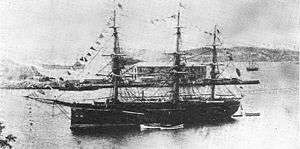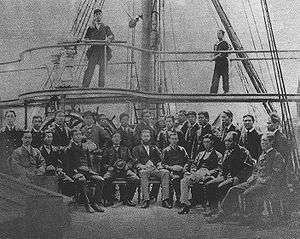Japanese ironclad Ryūjō
 | |
| History | |
|---|---|
| Name: | Ryūjō |
| Builder: | Alexander Hall and Company,[1] Aberdeen |
| Laid down: | 1868[1] |
| Launched: | |
| Completed: | |
| Decommissioned: | 2 December 1893[3] |
| Fate: | |
| General characteristics | |
| Displacement: | 2,530 long tons (2,571 t) standard[4][5][6][7] |
| Length: | |
| Beam: | |
| Draught: | 6 m (19 ft 8 in)[5] |
| Propulsion: | 1-shaft reciprocating;[5] 800 hp (600 kW)[5][6][7] |
| Speed: | 6 knots (6.9 mph; 11 km/h)[5] |
| Complement: | 275 people capacity in October 1873[8] |
| Armament: | 6 × 64 lb Krupp guns, other[4][5] |
| Armour: |
|
Ryūjō (龍驤), was a steam ironclad warship of the Imperial Japanese Navy, designed by Thomas Blake Glover and built in Scotland for the private navy of the fief of Kumamoto, where it was called the Jo Sho Maru.[1] It was delivered to the new Imperial Japanese Navy on 8 May 1870, and sailed from Nagasaki to Yokohama with a British captain, and named Ryōshō (龍驤 りょうしょう), later called Ryūjō (龍驤 りゅうじょう).[2][4] Until the commissioning of the ironclad Fusō in 1878, she was the flagship (and the most powerful ship) of the Imperial Japanese Navy.
Ryūjō was honored by a visit by Emperor Meiji in 1871,[4][9] and formed part of the escort of Russian Crown Prince (later Emperor) Nicholas II, when he visited Japan in 1872. Although completed too late for the Boshin war, the ship participated in the battles of the early Meiji period, including the Saga Rebellion, Seinan War and the first Taiwan Expedition of 1874.
From February through September 1872, Ryūjō made a training cruise from Shinagawa to Singapore, Batavia, Melbourne, Sydney and Auckland. On 15 September 1873, 169 crewmen (of a crew of 378) were stricken with food poisoning, of which 23 died. This incident led to the use of bread as the main diet of the Japanese navy.
On 26 October 1877, Ryūjō ran aground in high winds off Kagoshima, but she was successfully refloated the following year and brought to Yokosuka for repairs. From February to July 1881, she made port visits to Sydney, Melbourne in Australia and a circumnavigation of Tasmania. The following year, she made a second long-distance navigational training voyage to Wellingtion, Valparaíso, Callao and Honolulu. In 1895, she was dispatched to Korea as part of a Japanese show of force following the Gapsin Coup. In 1888, she made third long-distance navigational training voyage to Singapore, Batavia, Adelaide, Melbourne, Sydney and Auckland.[2]
She was derated to a third-class warship in 1890.[2]

Although formally decommissioned on 2 December 1893, the ship's guns were replaced with the latest Krupp cannon, and she continued to be used as a naval gunnery training vessel based at Yokosuka until 1908.
Notes
- 1 2 3 4 5 6 7 Aberdeen Built Ships.
- 1 2 3 4 5 Nihon Kaigun Shi Vol.7 1995, pp. 464-465.
- 1 2 Nihon Kaigun Shi Vol.7 1995, pp. 224-225, 464-465.
- 1 2 3 4 5 Rengō Kantai Gunkan Meimei Den 1993, p. 188.
- 1 2 3 4 5 6 7 8 Nihon Gunkan Shi 1995.
- 1 2 3 4 Nihon Kaigun Shi Vol.7 1995, pp. 224-225.
- 1 2 3 4 Nihon Kinsei Zōsen Shi 1911, p. 188.
- ↑ Kaigun Seido Enkaku Vol.10-1 1940.
- ↑ Shashin Nihon Kaigun Zen Kantei Shi 1994, p. 1244.
References
- Chesneau, Roger; Kolesnik, Eugene M., eds. (1979). Conway's All the World's Fighting Ships 1860–1905. Greenwich, UK: Conway Maritime Press. ISBN 0-8317-0302-4.
- Jentschura, Hansgeorg; Jung, Dieter; Mickel, Peter (1977). Warships of the Imperial Japanese Navy, 1869–1945. Annapolis, Maryland: United States Naval Institute. ISBN 0-87021-893-X.
- Scottish Samurai: The Life of Thomas Blake Glover by Alexander McKay (Canongate Books, 1993) ISBN 0-86241-455-5
- Zōsen Kyōkai, ed. (1911-01-05). Nihon Kinsei Zōsen Shi (in Japanese). Kōdōkan. ASIN B0092M9CWO.
- Ministry of the Navy of Japan, ed. (April 1972) [1940]. Kaigun Seido Enkaku Vol.10-1 (in Japanese). Meiji Hyaku Nen Shi Sōsho Vol.182. Hara Shobō.
- Daiji Katagiri (2014-04-08) [September 1993]. Rengō Kantai Gunkan Meimei Den (in Japanese). Usho Shobō Kōjin Sha. ISBN 978-4-7698-1565-5.
- Shizuo Fujii (1994). Shashin Nihon Kaigun Zen Kantei Shi (in Japanese). KK Bestsellers. ISBN 4-584-17054-1.
- Kaigun Rekishi Hozon Kai (Suikō Kai), ed. (1995-11-30). Nihon Kaigun Shi (in Japanese). 7. Daiichi Hōki Shuppan. ISBN 4-474-10058-1.
- Ships of the World No. 500 Extra No. 44 "Nihon Gunkan Shi" (in Japanese). Kaijin Sha. 1995. ISBN 4-905551-53-6.
- "JHO SHO MARU". Aberdeen Built Ships Project. Retrieved 2015-06-13.
External links
| Wikimedia Commons has media related to Ryujo (ship, 1864). |